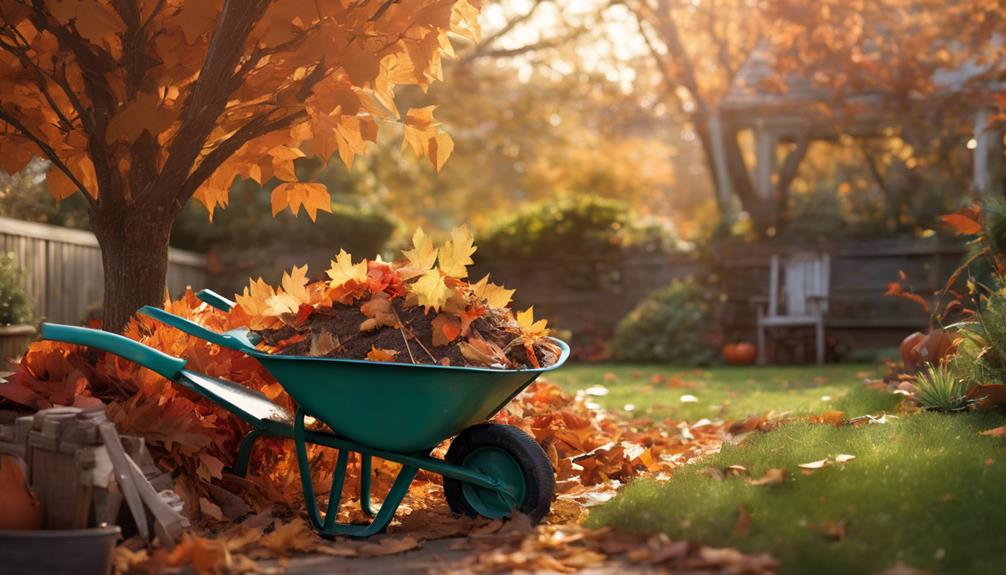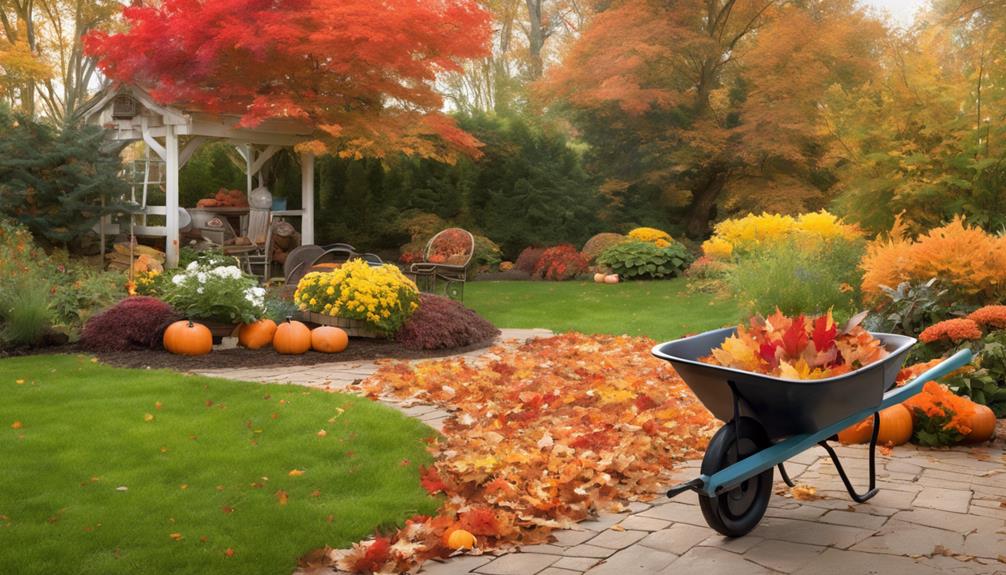
7 Tips for Seasonal Garden Cleanup Curb Appeal
15 October 2024
What Are Organic Ways for Seasonal Garden Cleanup?
15 October 2024Seasonal garden cleanup is essential for enhancing curb appeal and improving property aesthetics. By removing debris and dead plants, the garden achieves a polished appearance that reflects the owner's care.
Clear pathways and neatly trimmed hedges create visual harmony, signalling pride of ownership to passers-by. This meticulous attention not only improves initial impressions but can also increase property value in a competitive market.
Moreover, ideal timing and effective tools play a significant role in the cleanup process. For those interested in maximising their garden's potential, exploring supplementary techniques and strategies can yield impressive results.
Seasonal Cleanup Enhances Property Aesthetics
Seasonal cleanup plays a vital role in maintaining the cleanliness and organisation of your garden, which directly impacts the aesthetics of your property.
By removing debris and dead plant material, homeowners can create a polished appearance that enhances visual appeal.
Furthermore, selecting vibrant plants during this process not only rejuvenates the garden but also introduces a dynamic element that attracts attention.
Cleanliness and Organization
A thorough garden clean-up not only rejuvenates plants but also significantly enhances the overall aesthetics of your property.
Cleanliness and organisation are paramount in creating an inviting and polished outdoor environment. By removing debris, dead foliage, and clutter, the garden transforms into a cohesive and well-maintained space, reflecting the care and attention of its owner.
Clear pathways and well-defined borders improve visual appeal, guiding the eye through the landscape. Furthermore, organised elements, such as neatly trimmed hedges and strategically placed garden décor, contribute to a harmonious design.
This meticulous attention to detail signals pride of ownership, ultimately elevating the property's kerb appeal and potentially increasing its market value. Embracing cleanliness and organisation is crucial for any discerning property owner.
Vibrant Plant Selection
How can vibrant plant selection transform the visual appeal of your garden? The strategic incorporation of diverse, colourful flora can dramatically enhance your landscape's aesthetics, creating a striking visual symphony.
By selecting plants that exhibit varying textures, heights, and seasonal blooms, you establish a dynamic composition that captivates the eye throughout the year.
Integrating native and adapted species not only increases visual interest but also promotes biodiversity and ecological resilience.
Seasonal cleanup facilitates the installation of vibrant selections, ensuring ideal growth conditions and reducing competition from weeds. This proactive approach allows for the thoughtful arrangement of plants, which can frame pathways and focal points, ultimately improving your property's kerb appeal and inviting admiration from passers-by.
Embrace vibrant plant selection for an enviable garden masterpiece.
Optimal Timing for Cleanup
Determining the ideal timing for garden cleanup is crucial, as it directly influences local climate considerations and overall soil health.
By implementing suitable cleanup techniques, gardeners can effectively enhance soil vitality while simultaneously managing pest control measures.
Understanding these factors will ensure that cleanup efforts yield the best possible results for both the garden and the surrounding environment.
Local Climate Considerations
While the changing seasons signal the need for garden maintenance, local climate conditions play a crucial role in determining the best timing for cleanup activities.
Understanding your specific climate can enhance the effectiveness of your efforts and ultimately elevate curb appeal.
Consider the following factors:
- Frost Dates: Knowledge of the last frost date aids in scheduling cleanup to protect tender perennials.
- Rainfall Patterns: Timing cleanup after heavy rains can prevent soil compaction and facilitate easier debris removal.
- Temperature Variations: Seasonal temperature fluctuations influence plant dormancy, guiding when to prune or remove dead foliage.
Soil Health Improvement Techniques
To achieve a thriving garden, prioritising soil health during seasonal clearance is essential.
Ideal timing for clearance not only improves aesthetics but also fosters a robust foundation for plant growth. Implementing effective soil health improvement techniques can lead to long-term benefits.
- Timing of Clearance: Conduct clearance after the last frost to preserve beneficial microorganisms.
- Organic Amendments: Incorporate compost and well-matured manure to enrich soil nutrient profiles.
- Soil Testing: Regularly assess pH and nutrient levels to tailor amendments for specific plant needs.
Pest Control Measures
Effective pest control measures are crucial during seasonal garden cleanup, as they can significantly influence the health and productivity of your plants.
Implementing timely cleanup strategies not only removes potential breeding grounds for pests but also enhances the overall appearance of your garden.
Consider the following measures:
- Remove debris: Clear away fallen leaves and dead plant material to eliminate hiding spots for pests.
- Inspect plants: Regularly examine your plants for early signs of infestations, allowing for swift intervention.
- Apply organic treatments: Utilise natural pest deterrents to protect beneficial insects while managing harmful populations.
Cleanup Tool Selection
Selecting the right tools for garden clearance is crucial for maintaining an efficient workflow.
This includes gathering necessary clearance supplies, understanding proper mulching techniques, and implementing effective soil aeration methods.
Gather Necessary Cleanup Supplies
Gathering the right cleanup supplies is vital for an efficient and thorough seasonal garden cleanup. Selecting the appropriate tools not only expedites the process but guarantees that each task is performed to the highest standard.
A well-equipped gardener can tackle debris removal, pruning, and soil preparation effectively, ultimately enhancing the garden's overall appearance.
Consider including the following key items in your toolkit:
- Heavy-duty gloves: Protect your hands from sharp objects and harmful plants.
- Pruning shears: Ensure clean cuts on branches and plants, promoting healthy growth.
- Rake: Efficiently gather leaves and debris, improving the garden's tidy aesthetic.
Proper Mulching Techniques
A gardener's choice of mulching tools can greatly influence the success of their seasonal cleanup efforts.
Selecting the right tools not only enhances the efficiency of the process but also ensures superior mulching results that benefit plant health and enhance curb appeal.
Mastery in mulching begins with understanding the fundamental tools available:
- Mulching Fork: Ideal for turning and aerating existing mulch, ensuring even distribution.
- Garden Rake: Crucial for levelling and spreading mulch uniformly across garden beds.
- Wheelbarrow: Facilitates easy transportation of mulch materials, reducing physical strain and saving time.
Soil Aeration Techniques
Effective soil aeration is a fundamental component of seasonal garden clean-up, complementing the benefits gained from proper mulching techniques.
Aeration improves nutrient absorption, enhances drainage, and promotes healthy root development. Selecting the right tools for this task is essential for maximising effectiveness.
Consider the following aeration techniques:
- Core Aerators: These remove plugs of soil, allowing air and water to penetrate deeply, fostering a healthier root system.
- Spike Aerators: Utilising spikes to perforate the soil surface, these are ideal for lighter soil types but may not provide the same depth as core aerators.
- Manual Aerators: Perfect for small gardens, these tools offer precision and control, ensuring targeted aeration in compacted areas.
Incorporating these techniques will greatly improve your garden's health and curb appeal.
Increased Property Value
Enhancing the aesthetics and functionality of your garden through seasonal cleanup can significantly boost your property's value. A well-maintained garden not only attracts potential buyers but also fosters a sense of pride in ownership. Clean, manicured landscapes create a positive initial impression and can lead to higher offers.
| Aspect | Impact on Property Value | Seasonal Cleanup Benefits |
|---|---|---|
| Curb Appeal | Increases buyer interest | Improves visual attractiveness |
| Maintenance Costs | Reduces future expenses | Minimises long-term upkeep |
| Market Competitiveness | Sets your property apart | Positions for higher valuation |
Investing time in seasonal garden cleanup directly translates to improved property value, making it an essential practice for homeowners looking to optimise their investment.
Landscape Design Implementation
Effective landscape design implementation requires a thoughtful approach that incorporates native plant integration, which enhances biodiversity and sustainability.
Furthermore, seasonal fertilisation techniques are crucial for promoting healthy growth and vigour in your garden.
Ultimately, the application of organic pest repellents can safeguard your plants while maintaining an eco-friendly environment.
Native Plant Integration
Integrating native plants into landscape design is a powerful strategy that promotes ecological balance and enhances biodiversity. By selecting plants that are indigenous to the region, homeowners can create a harmonious environment that supports local wildlife and minimises resource consumption.
This approach not only boosts aesthetic appeal but also fosters resilience against pests and diseases.
- Enhanced Wildlife Habitat: Native plants attract pollinators and other beneficial organisms, supporting local ecosystems.
- Reduced Maintenance: These plants typically require less water and fewer chemical inputs, resulting in lower upkeep costs.
- Climate Adaptation: Native species are well-suited to local climate conditions, offering sustainability and longevity in landscape design.
Embracing native plant integration is crucial for creating thriving, sustainable landscapes.
Seasonal Fertilization Techniques
A well-planned seasonal fertilisation strategy is crucial for maintaining the health and vitality of a landscape, especially when native plants are incorporated into the design.
Proper fertilisation improves soil fertility, promotes robust plant growth, and ensures the landscape remains visually appealing.
Key techniques to consider include:
- Soil Testing: Assess nutrient levels to tailor fertilisation to specific soil needs.
- Timing: Apply fertilisers during the ideal growth periods, typically in spring and autumn, to optimise uptake.
- Type of Fertiliser: Use slow-release or organic fertilisers to support long-term soil health and minimise environmental impact.
Implementing these strategies will greatly enhance the effectiveness of seasonal fertilisation, ensuring a thriving and attractive landscape.
Organic Pest Repellent Application
Utilising organic pest repellents in landscape design enhances both plant health and environmental sustainability.
These natural solutions not only deter harmful insects but also minimise the negative impacts associated with synthetic chemicals. Implementing organic pest repellents fosters a balanced ecosystem, protecting beneficial organisms crucial for pollination and pest control.
Key advantages include:
- Enhanced Soil Health: Organic repellents often contain nutrients that promote beneficial microbial activity.
- Biodiversity Support: They encourage the presence of natural predators, such as ladybirds, that help manage pest populations.
- Reduced Chemical Exposure: Using organic options decreases the risk of chemical runoff, safeguarding local waterways and wildlife.
Integrating organic pest repellent application into landscape design is a proactive strategy for sustainable gardening.
Frequent Weather-Related Disruptions
Frequent weather-related disruptions can significantly affect the scheduling of garden cleanup tasks.
To effectively manage these interruptions, it is essential to adopt flexible cleanup scheduling options that accommodate unpredictable weather patterns.
This adaptability not only ensures that garden maintenance is timely but also optimises the use of resources throughout the changing seasons.
Weather-Dependent Cleanup Scheduling
Navigating the challenges of weather-dependent cleanup scheduling necessitates a keen awareness of local climate patterns and seasonal variations.
Gardeners must anticipate how fluctuating weather conditions can disrupt planned activities, leading to delays in essential maintenance tasks. Proactive planning ensures that cleanup efforts align with favourable weather, maximising efficiency and effectiveness.
- Monitor local forecasts to identify ideal cleanup windows.
- Analyse historical weather data to predict seasonal trends.
- Maintain flexibility in scheduling to accommodate sudden weather changes.
Flexible Cleanup Scheduling Options
Adapting cleanup schedules to accommodate frequent weather-related disruptions is vital for maintaining a healthy garden. Flexibility in scheduling allows gardeners to respond effectively to unpredictable conditions, ensuring that fundamental maintenance tasks are performed promptly.
By implementing strategic planning, one can optimise the timing of seasonal cleanup efforts.
- Monitor weather forecasts regularly to adjust cleanup plans accordingly.
- Prioritise tasks based on immediate environmental conditions to prevent damage.
- Utilise technology, such as garden management apps, to streamline scheduling and reminders.
Incorporating these practices improves the garden's resilience and aesthetic appeal, ultimately contributing to a well-maintained landscape.
Mastering adaptable scheduling not only enhances the garden's health but also remarkably raises curb appeal, reflecting the gardener's dedication and expertise.
Flexible Scheduling for Weather Changes
Weather fluctuations can significantly impact garden maintenance, necessitating a flexible approach to scheduling cleanup activities.
Adapting to frequent weather-related disruptions ensures that your garden remains pristine and appealing throughout the seasons. By implementing a responsive strategy, you can manage tasks more efficiently and effectively.
- Monitor Weather Patterns: Stay informed about forecasts to anticipate rain or extreme temperatures that may delay cleanup.
- Prioritise Tasks: Identify critical tasks that can be executed in shorter windows of favourable weather.
- Utilise Technology: Employ gardening apps or weather alerts to facilitate real-time adjustments to your schedule.
This adaptive methodology not only enhances the aesthetic appeal of your garden but also optimises labour and resources, ultimately leading to a more successful seasonal cleanup.
Why Choose TKL Birmingham Gardener
Choosing the right gardening service can make all the difference in maintaining a vibrant and healthy outdoor space. TKL Birmingham Gardener stands out as a premier choice, renowned for its expertise and commitment to excellence.
With a team of skilled horticulturists, TKL employs tailored strategies to enhance your garden's aesthetic and ecological health. Their comprehensive seasonal clean-up services guarantee meticulous attention to detail, addressing everything from debris removal to soil revitalisation.
In addition, TKL utilises sustainable practices, promoting long-term garden vitality while minimising environmental impact. Clients benefit from personalised consultations and flexible scheduling that accommodates individual needs.
Common Cleanup Questions Answered
As the gardening season approaches, many homeowners find themselves with numerous questions regarding seasonal cleanup. One common query is: when is the best time to begin cleanup? Ideally, this should occur after the last frost but before new growth emerges.
Another frequent concern pertains to what debris should be removed; consider clearing dead leaves, spent annuals, and any invasive weeds that might compete with emerging plants.
Furthermore, homeowners often wonder about the importance of soil preparation during cleanup. Aerating and improving the soil promotes healthy plant growth.
Plan for Future Seasons
After addressing the immediate needs of your garden during seasonal clearance, it is crucial to contemplate strategies for future seasons.
This proactive approach not only enhances your garden's resilience but also optimises its aesthetic appeal throughout the year.
Consider implementing the following strategies to ensure longevity and vibrancy:
- Diverse Plant Selection: Incorporate a variety of species that bloom at different times to maintain visual interest across the seasons.
- Soil Health Management: Regularly amend soil with organic matter to boost its fertility and structure, ensuring robust plant growth.
- Seasonal Rotation: Plan for crop rotation or floral changes to prevent pest build-up and promote soil rejuvenation.




